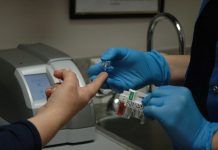SAN DIEGO - April 2003 - The name is misleading but diabetes insipidus is not associated with diabetes mellitus (which is also called sugar diabetes). Victims of this disorder have kidneys that fail to adequately concentrate urine very well, leading to increased frequency of urination. Diabetes insipidus patients are thirsty all the time, finding the need to consume liquids every hour. The causes of diabetes insipidus are unclear. In some, a part of the brain (called the hypothalamus) doesn't make enough antidiuretic hormone (called ADH, and also called by its chemical name, arginine-vasopressin or AVP); in others, the kidneys don't work with this hormone the way they should. Most people with diabetes insipidus are diagnosed following an injury to the head or after brain surgery. A brain tumor is sometimes present in those with this disease; about one in four have no discernible reason for diabetes insipidus.
A new study conducted under the auspices of the Departments of Defense and Army may have found that prenatal ethanol exposure in rats can lead to a partial central diabetes insipidus evident in the young adult. This is supported by the observations that pre-natal ethanol (PE)-exposed rats drank twice as much water, had reduced pituitary content of AVP, a 50 percent reduction in the genetic material in the hypothalamus necessary for the synthesis of AVP, a reduced response of AVP release to an osmotic stimulus, and increased basal plasma salt concentration (osmolality). [Note: Vasopressin regulates blood volume and salt concentration. Animals deprived of water detect increases in salt concentration in the hypothalamus, which causes the release of vasopressin, thereby increasing water retention. Feedback from the kidneys, through release of renin and activation of angiotensin, elevates blood pressure and leads to activation of cells in the lateral hypothalamus, which control drinking behavior.]
These findings may be significant for those suffering from diabetes insipidus of unknown origin. A pathogenesis related to fetal alcohol syndrome could offer signposts for developing effective treatments for this debilitating disorder.
Background
Chronic consumption of alcohol has been shown to significantly reduce the number of arginine vasopressin (AVP)-producing neurons in the rat supra optic nucleus. More recently, chronic alcoholism in humans has also been shown to reduce AVP-producing neurons in a dose-related and time-dependent manner. Furthermore, AVP synthesis is reduced, evidenced by reduced AVP mRNA in the hypothalamus of rats chronically administered alcohol, and there is a reduced AVP mRNA response to an osmotic stimulus in similarly treated rats. Correspondingly, chronic exposure to alcohol in man has been reported to reduce plasma levels of AVP, and cerebrospinal fluid levels of AVP. Thus, the AVP system would appear to be impaired by chronic alcohol exposure in adult animals and humans.
Continue Reading Below ↓↓↓
Lastly, there is evidence that AVP systems are nearly fully developed during gestation. AVP has been identified as early as 11 weeks of gestation in the neurohypophysis of the human fetus. Furthermore, animal studies have shown that osmoreceptor, baroreceptor, and chemoreceptor stimulatory pathways for AVP release are present during fetal development.
Since long-term use of ethanol in adults is associated with impairment, and probably permanent damage, to the vasopressinergic systems in the brain, and brain damage is known to occur to a fetus exposed to alcohol, a team of researchers suggested that damage could be done to the developing vasopressinergic systems in the brain.
Only two previous animal studies have been reported on water and electrolyte regulation and vasopressin responses in association with prenatal ethanol (PE) exposure. The present study was conducted to improve understanding of AVP regulation in young adult rats after PE exposure. Researchers hypothesized that regulatory mechanisms would be altered in the PE-exposed rats; specifically the osmoreceptor control mechanism would be impaired.
A New Study
The authors of �Prenatal Exposure to Ethanol Causes Partial Diabetes Insipidus in Adult Rats, � are Daniel S Knee, Aileen K Sato, Catherine F.T. Uyehara and John R Claybaugh, all with the Tripler Army Medical Center, Tripler AMC, HI. The researchers are presenting their findings at the upcoming American Physiological Society sponsored conference, Experimental Biology 2003, being held April 11-15, 2003, at the San Diego Conference Center, San Diego, CA.
Methodology
Pregnant rats were fed a liquid diet with 35 percent of the calories from ethanol or a control liquid diet for days 7 to 22 of pregnancy. Water consumption was measured in the adult offspring over a 48-hour period. Subsequently, the offspring were infused with five percent NaCl at 0.05 ml�kg-1�min-1 with plasma samples taken prior to and at three 40-minute intervals during infusion for measurement of AVP and osmolality.
Results
The female rats exposed to ethanol had an average body weight of 275 gr at the beginning of pregnancy and gained 68 gr during the pregnancy and consumed an average daily caloric intake of 262 kcal/kg/day which included an average daily consumption of 16 ml/kg of ethanol. The female rats that were not exposed to ethanol (NPE rats) had corresponding average values of 290 gr initial body weight, a 137 gr weight gain during pregnancy, and an average daily caloric intake of 265 kcal/kg/day. The average body weight of the PE-exposed rats on day 7 of life was 14.1 + 0.4 (SE) grams, and the average for the NPE-exposed rats on day 7 of life was 12.9 + 0.2 grams. However, there were 29 pups in the NPE liters versus only 19 pups in the PE liters.
At time of surgery the average body weight for the PE-exposed female rats was not significantly different from the average body weight for the NPE-exposed female rats, 227 + 6 gr versus 222 + 3 gr respectively. The PE-exposed male rats were slightly heavier than the NPE male rats, 356 + 6 gr versus 336 + 4 gr respectively (p = 0.02).
Continue Reading Below ↓↓↓
PE-exposed rats consumed roughly 2 times more water per day than NPE-exposed rats. Females in both groups drank about 30 percent more than males in both groups. The basal plasma AVP levels were obtained prior to the initiation of the infusion. The PE and NPE-exposed rats had similar basal levels of AVP. This similarity of AVP levels continued throughout the infusion of 0.9 percent NaCl. Although the basal plasma AVP levels were similar between PE and NPE-exposed rats, the basal plasma osmolality was increased in the PE rats, suggesting a reduced sensitivity of the AVP system to osmolality. In fact, when a concentrated salt solution was infused into the rats in order to stimulate AVP, the release of AVP was impaired in the PE-exposed rats compared to the NPE-exposed rats. In addition, the pituitary gland content of the AVP was reduced and the hypothalamus synthesis of AVP was greatly reduced in the PE-exposed rats. This overall reduction in AVP synthesis and release results in an inability to conserve water. Hence, the rats must drink more water in order to maintain water balance.
Conclusions
Our findings revealed that PE exposure was associated with an increase in water intake in both males and females. This is consistent with a decreased AVP release and consequent loss of free water and constant state of dehydration and polydipsia.
The researchers believe that the involvement of vasopressin in learning and memory, and other behavioral processes may lead to research addressing the possibility that mental retardation that can accompany fetal alcohol syndrome may be due to depressed vasopressinergic brain systems.
The American Physiological Society (APS) is one of the world�s most prestigious organizations for physiological scientists. These researchers specialize in understanding the processes and functions underlying human health and disease. Founded in 1887 the Bethesda, MD-based Society has more than 10,000 members and publishes 3,800 articles in its 14 peer-reviewed journals each year.
Source: San Diego Convention Center










